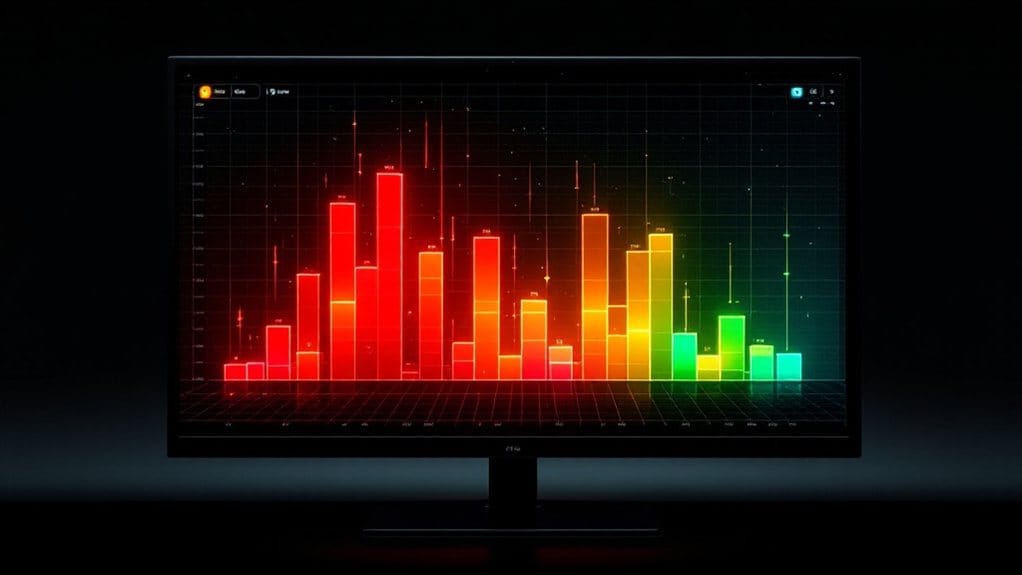In 2024, Kaspa leads cryptocurrency mining profitability with daily earnings of $76.99, while Bitcoin remains a stable choice despite high hardware requirements and energy costs. Monero attracts miners with its ASIC-resistant RandomX algorithm, suitable for CPU mining, and Ravencoin offers accessibility for budget-conscious operators. Litecoin and Ethereum Classic present viable alternatives through their respective Scrypt and Etchash algorithms, with profitability varying based on electricity costs and equipment investment. This complex ecosystem of mining opportunities reveals multiple paths toward potential returns.

As the cryptocurrency landscape continues to evolve in 2024, miners face increasingly complex decisions about which digital assets offer the most profitable mining opportunities. The profitability equation hinges on several essential factors, including mining difficulty, hardware requirements, and electricity costs, with successful operations typically requiring access to affordable power sources and efficient mining equipment.
Bitcoin remains a dominant force in mining profitability, despite its high mining difficulty, primarily due to its substantial market value and established position. However, alternative cryptocurrencies like Litecoin, utilizing the Scrypt algorithm, and Monero, with its ASIC-resistant RandomX algorithm, present viable options for miners seeking different entry points into the market. Each Bitcoin block mined rewards miners with 3.125 BTC per block. The most profitable cryptocurrency to mine currently is Kaspa, with daily profits of $76.99.
Despite Bitcoin’s dominance in mining, altcoins like Litecoin and Monero offer alternative pathways into cryptocurrency mining through different algorithmic approaches.
Particularly significant is Ravencoin, which has emerged as a favorable choice for budget-conscious miners due to its ASIC resistance and GPU-friendly mining protocol. Ethereum Classic mining remains highly accessible due to its optimized Etchash algorithm design.
The hardware requirements differ greatly across different cryptocurrencies, with Bitcoin mining necessitating high-end ASIC machines, while alternatives like Monero can be mined effectively using CPU or GPU setups. This technological diversity creates opportunities for miners at multiple investment levels, though the initial equipment costs and ongoing electricity expenses continue to shape profit margins considerably.
Market performance and volatility play vital roles in determining mining profitability, with cryptocurrencies experiencing frequent price fluctuations that directly impact mining revenues. For instance, Monero has demonstrated strong profitability potential for CPU miners, while Ethereum Classic and Ravencoin offer accessible entry points for GPU mining operations.
The emergence of mining pools has also transformed the landscape, allowing smaller operators to participate in mining activities that would otherwise be dominated by large-scale ASIC operations.
Economic considerations remain paramount, with successful mining operations requiring careful analysis of electricity costs, equipment investment, and potential payback periods. While some miners opt for traditional proof-of-work mining, alternatives such as staking have gained popularity as more energy-efficient methods of participating in cryptocurrency networks, particularly among those seeking to minimize initial hardware investments and operational costs.
FAQs
What Are the Minimum Electricity Costs Needed for Profitable Crypto Mining?
Profitable crypto mining requires electricity costs below $0.12 per kWh for most cryptocurrencies, with Bitcoin demanding approximately 6,400,000 kWh per coin.
Regional variations notably impact profitability, as evidenced by Iran’s low rate of $1,324.17 per Bitcoin mined.
Miners typically seek locations with rates under $0.05 per kWh, utilizing renewable energy sources or establishing operations in areas like Texas and Canada, where electricity costs remain consistently low.
How Often Should Mining Hardware Be Upgraded to Maintain Profitability?
Mining hardware typically requires upgrades every 18-24 months to maintain ideal profitability, though this timeline can vary based on network difficulty increases and technological advancements.
Operators should evaluate their equipment when hash rates decline by 20-30% compared to newer models, or when energy efficiency drops below 38J/TH.
Major upgrades may be necessary more frequently during bull markets when mining difficulty increases rapidly and competition intensifies.
Which Mining Pools Offer the Best Rewards and Lowest Fees?
Litecoinpool stands out with zero fees and reliable payouts, while Slush Pool maintains competitive rates at 2% for Bitcoin mining with consistent rewards.
F2Pool offers balanced fee structures across multiple cryptocurrencies, typically ranging from 1-3%, and ViaBTC provides attractive PPS+ payment methods with fees around 2%.
P2Pool’s decentralized approach eliminates traditional fees but requires more technical expertise to operate effectively.
Are ASICS or GPU Mining Rigs Better for Beginners?
For cryptocurrency mining beginners, GPU rigs offer greater flexibility and lower initial risk despite their complexity.
While ASICs provide superior hash rates for specific coins, their single-purpose design and high costs make them less beginner-friendly.
GPU setups allow miners to switch between different cryptocurrencies, maintain resale value, and start with modest investments, though they require more technical knowledge for setup and maintenance compared to plug-and-play ASIC systems.
What Backup Cryptocurrencies Should Miners Consider During Market Downturns?
During market downturns, miners should prioritize ASIC-resistant cryptocurrencies like Monero (XMR) and Ravencoin (RVN), which remain accessible for GPU and CPU mining.
Alternative options include privacy-focused coins such as Zano (ZANO) and VerusCoin (VRSC), which offer strong CPU mining potential.
Furthermore, established alternatives like Ethereum Classic (ETC) provide stability, while emerging options like Nerva (XNV) can deliver notable profitability despite market conditions.









